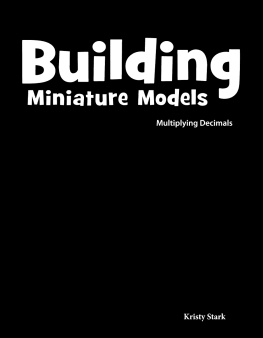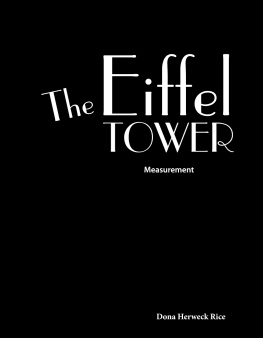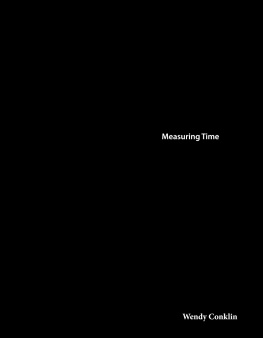Kristy Stark - The History of Telephones: Fractions
Here you can read online Kristy Stark - The History of Telephones: Fractions full text of the book (entire story) in english for free. Download pdf and epub, get meaning, cover and reviews about this ebook. year: 2018, publisher: Teacher Created Materials, genre: Detective and thriller. Description of the work, (preface) as well as reviews are available. Best literature library LitArk.com created for fans of good reading and offers a wide selection of genres:
Romance novel
Science fiction
Adventure
Detective
Science
History
Home and family
Prose
Art
Politics
Computer
Non-fiction
Religion
Business
Children
Humor
Choose a favorite category and find really read worthwhile books. Enjoy immersion in the world of imagination, feel the emotions of the characters or learn something new for yourself, make an fascinating discovery.
- Book:The History of Telephones: Fractions
- Author:
- Publisher:Teacher Created Materials
- Genre:
- Year:2018
- Rating:4 / 5
- Favourites:Add to favourites
- Your mark:
- 80
- 1
- 2
- 3
- 4
- 5
The History of Telephones: Fractions: summary, description and annotation
We offer to read an annotation, description, summary or preface (depends on what the author of the book "The History of Telephones: Fractions" wrote himself). If you haven't found the necessary information about the book — write in the comments, we will try to find it.
The History of Telephones: Fractions — read online for free the complete book (whole text) full work
Below is the text of the book, divided by pages. System saving the place of the last page read, allows you to conveniently read the book "The History of Telephones: Fractions" online for free, without having to search again every time where you left off. Put a bookmark, and you can go to the page where you finished reading at any time.
Font size:
Interval:
Bookmark:
0covercover.xhtmlThe History of Telephones Fractions Kristy Starkcover1page0001page0001.xhtmlMath Talk 1. How are tenths and hundredths related to one whole? 2. What adjustments can you make to a tenths grid to make it a hundredths grid? 3. How can a fraction in tenths be renamed as an equivalent fraction in hundredths? 4. Which fractions in the set are equivalent :,,? How do you know? 5. While working with tenths and hundredths, Alex says, This reminds me of working with dimes and pennies. What do you think he means by that? 6. What strategies can you use to find the sum of a fraction with a denominator of 10 and a fraction with a denominator of 100?22page0002page0002.xhtmlThe History of Telephones Fractions33page0003page0003.xhtml44page0004page0004.xhtmlTable of Contents Traveling Back in Time 4 Meeting Mr Bell and Mr Watson 8 Changing Phone Designs 14 Exploring the 1960s and 1970s 18 Phones Get Smarter 22 Returning Home 26 Problem Solving 28 Glossary 30 Index 31 Answer Key 32 This is a work of fiction Characters, businesses, events, and incidents are either the products of the author's imagination or used in a fictitious manner Any resemblance to actual persons, living or dead, or actual events is purely coincidental55page0005page0005.xhtmlTraveling Back in Time It is getting late, and the sun is about to set. Bryce hopes he can use the last bit of daylight to finish his work. The old telephone booth is a great find from the junkyard. It is the perfect contraption for making a time machine. Bryce has been working on his time machine for several months. His scientist parents built their own time machines when they were about his age. They helped him when he needed it, but he was able to do most of the work on his own. As the sun begins to set, Bryce tightens the final screw on the machine's control panel. There, that should do it, he says. The only thing left to do is test the machine. Bryce sits on the seat he bolted to the inside of the telephone booth and buckles his seat belt. Then, he thinks about where he should travel first.66page0006page0006.xhtmlLET'S EXPLORE MATH It takes Bryce 10 months to complete his time machine. In June, July, and August, he doesn't work on the time machine because he is away at summer camp. 1. What fraction of the 10-month period does Bryce work on the machine? Color a tenths grid to show your solution. 2. What fraction of the 10-month period does Bryce not work on the machine? Use a different color to show this amount on the same tenths grid. Tenths Grid77page0007page0007.xhtmlAfter a few minutes, Bryce decides there is only one logical place to go for his first trip in a phone booth. He wants to go back to when the telephone was first invented. On his computer, he types phone invented in the search field. The search engine finds the correct time period. Bryce selects the year to confirm his destination. The time machine makes a soft humming noise as it warms up. Bryce sends his mom and dad a quick text to let them know where he is going.88page0008page0008.xhtmlAt first, nothing happens. He looks down at the screen, confused. Suddenly, the booth starts to rattle and shake. There is a quick flash of light as his house disappears before his eyes. Okay, 1876, here I come! Bryce yells excitedly as he feels the phone booth fly through the air.99page0009page0009.xhtmlMeeting Mr. Bell and Mr. Watson After a few seconds, the phone booth lands in a small room. There is a desk that is covered with tools and papers. Bryce sees a device with a wooden base. It's the first telephone! Bryce unbuckles his seat belt. Then, he opens the phone booth's door slowly. He sees two men shaking hands. They look very happy. The men notice Bryce and say hello. They introduce themselves as Alexander Graham Bell and Thomas Watson. Bryce explains that he is from the future. He points to the device on the desk and asks, Can you tell me about your invention? Bell tells Bryce that his idea is based on the electric telegraph, which was invented by Samuel Morse in the 1830s. The telegraph uses a code of long and short pulses to send messages through an electric current.1010page0010page0010.xhtmlBell (left) and Watson (right) discuss their invention in 1876. LET'S EXPLORE MATH Imagine that a telegraph uses 10 pulses to send a message. The message has 6 long pulses and 4 short pulses. The fraction of the message with long pulses is. 1. Write an equivalent fraction for with a denominator of 100. Color a tenths grid and a hundredths grid to show this amount. = /100 2. What fraction represents short pulses? Write this fraction in tenths and hundredths. Use a different color to show this amount on the same grids. = Tenths Grid Hundredths Grid1111page0011page0011.xhtmlThis patent made it official that Bell owned the idea; only he could make or sell the invention.1212page0012page0012.xhtmlBell explains that he wanted to create a device that would use electricity to transmit speech. I am not an electrician. So, I hired Mr. Watson to help me, says Bell. On March 7, 1876, I received a patent for our work. I found out that another man had been working on a telephone as well. Elisha Gray was making one at the exact same time. He even filed for a patent on the same day! What are the odds of that? Lucky for me, I was the one to get the patent for the telephone. Is that why you looked so happy when I got here? asks Bryce. Bell replies, No, we were celebrating for a different reason. It has been three days since I received the patent. And today, Watson heard me speak through the telephone! Gray (right) files for a telephone patent on the same day as Bell (left).1313page0013page0013.xhtmlBryce is amazed. What did you say to Mr. Watson? he asks. I said, Mr. Watson, come here. I want to see you. ' He was in another room and heard me through the telephone. Isn't that amazing? I believe this telephone is going to change the world as we know it. Do you think that someday everyone will have a telephone? Your invention will definitely change everything, Mr. Bell. I know that everyone in the world will have a telephone. In a little over one hundred years, people will even have telephones that fit in their pockets. Bell and Watson laugh as they pat each other on the back. Telephones for everyone! laughs Watson as he shakes his head. Thank you for your time, Mr. Bell and Mr. Watson. I need to get going. I have several more stops to make, says Bryce as he buckles his seat belt. As the time machine warms up, Bryce wonders whether the men realize just how much their invention will impact future generations.1414page0014page0014.xhtmlWatson hears Bell's voice through the telephone for the first time.1515page0015page0015.xhtmlChanging Phone Designs Bryce decides he wants to learn how phones changed after Bell's design. He travels from the 1880s to the early 1900s. He sees that phones changed greatly during this time. They look very different from Bell's original phone. Bryce continues through time. He watches as people get phones for their homes and businesses. He sees a candlestick phone. In the 1890s, the first candlestick phones had two separate pieces. One piece was held up to the mouth. The other piece was held to the ear. This made it possible to listen to the person on the other end of the phone line. In the late 1920s, a new design connected the mouthpiece to the receiver. Bryce also sees men building public phone booths. These booths are more elegant than Bryce's phone booth. The booths have rugs and lace curtains. They have fancy cabinets made of polished wood, too.1616page0016page0016.xhtml1876 1892 19271717page0017page0017.xhtmlBryce watches as workers put up phone poles and phone lines. More and more phone lines are needed as more people have phones in their homes and offices. Bryce learns that by 1919, most people had rotary phones. These phones have circular dials with digits 0 through 9. People rotated the dial to a digit and then released it. People repeated this process for each digit of the phone number. Bryce dials his home phone number on the rotary phone. He is shocked by how long it takes to dial! Thank goodness this phone was replaced, Bryce thinks. It takes way too long to make a call! Bryce wonders exactly when the rotary phone was replaced by push buttons. He types his query into the search field on his computer. He selects the time period. It doesn't take long before Bryce is on his way again! rotary phone from the 1920s1818page0018page0018.xhtmlA lineman works on a phone pole in 1920. LET'S EXPLORE MATH A dial on a rotary phone has 10 digits from 0 to 9. On the dial, of the digits are odd and of the digits are even. Color a tenths grid and a hundredths grid to show the fractions of odd and even digits on the rotary phone. Then, add the fractions by writing equivalent fractions. Tenths Grid Hundredths Grid1919page0019page0019.xhtmlExploring the 1960s and 1970s For his next stop, Bryce lands in 1963. He is at the headquarters of the American Telephone and Telegraph Company (AT&T). Bryce sees the Touch-Tone telephone. He learns that it was the first push-button phone on the market. The Touch-Tone is not like the rotary phone. This phone has a keypad to dial numbers. Each key has a unique frequency. Each frequency sends a signal to the operator to tell which digit was dialed. Touch-Tone telephone from 19632020page0020page0020.xhtmlBryce sees another machine in the company's office. It does not look like anything he's ever seen. It has buttons and a light that blinks. It looks like a small box. Bryce learns that the box is an answering machine. People used answering machines when they weren't able to answer their phones. Messages were recorded on cassette tapes. They were used by many people until the early 2000s. This 1970s answering machine included a transmitter that could play a message from a different location.2121page0021page0021.xhtmlBryce thinks about where he would like to go next. He decides to travel to see the invention of the first cell phone. He is surprised to learn that it was invented about 10 years after the first push-button phone. Bryce lands in 1973. He meets Martin Cooper, an engineer. Cooper works for a company called Motorola. He tells Bryce that people want to be able to make phone calls at anytime and from anywhere. Cooper says, I made my first phone call from a sidewalk in New York City. I called my rival, Joel Engel. He works for Bell Labs. I just wanted him to know that I beat him to the punch I invented the first cellular phone! The first cell phone was sold about 10 years later, in 1984. But, more research needed to be done to perfect it. Not many people had one. It was very expensive. It cost about $4, 000! Bryce learns that people could only talk for about 30 minutes at a time on these phones. Then, the phones had to be charged for 10 hours! cellular phone from 19842222page0022page0022.xhtmlCooper poses with his invention. LET'S EXPLORE MATH The first cell phone took 10 hours to charge. Imagine that Martin Cooper charged his phone for 4 hours in the morning and 6 hours in the evening. 1. Color a tenths circle to show the fraction of time that the phone charged in the morning. Color a hundredths circle to show the fraction of time that the phone charged in the evening. 2. What fraction represents the total amount of time Cooper charged his phone? Write the answer in tenths and hundredths. Tenths Circle Hundredths Circle2323page0023page0023.xhtmlPhones Get Smarter Just as Bryce ponders what he would do if he had to wait 10 hours for his phone to charge, he gets a text from his mom. She wants him to head home soon. Dinner is almost ready. One more stop, Bryce texts back. Bryce knows that cell phones changed a lot after 1973. Phones were made smaller and had longer-lasting batteries. Games and cameras were added to phones, too. Bryce is starting to realize just how much the invention of the smartphone revolutionized the way people communicate. And that's exactly what he wants to see next! Steve Jobs introduces the iPhone in San Francisco, California, in 2007.2424page0024page0024.xhtmlThe time machine takes Bryce to 2007. He is at Apple headquarters. He sees Steve Jobs introducing the iPhone . Jobs explains that this new phone does more than make calls and take pictures. It has a touch screen and works like a mini computer. The phone can browse the Internet, play music, use apps, and send texts. Bryce, of course, knows all of this. But, he is grateful to witness this moment in history. Before now, he hadn't realized that the iPhone was launched the same year he was born. Wow, 2007 was an important year for so many reasons! Bryce thinks. LET'S EXPLORE MATH Bryce asks 10 friends how they most frequently use their smartphones. He asks them to choose from the following categories : music, email, Internet browsing, and games. Bryce records their responses in the tenths circle shown below. Smartphone Usage music email Internet browsing games 1. Write a fraction for each category of the tenths circle. 2. Rename each fraction in hundredths. 3. What fraction of students uses their smartphones for music and games? Write this fraction in tenths and hundredths.2525page0025page0025.xhtmlBryce returns to his phone booth. He searches on his computer to learn more about smartphones. He discovers that the first Android phone was introduced in 2008. It was called the HTC Dream . Bryce learns that both types of smartphones have similar features, but each uses a different operating system. An operating system is the main program in a computer. It helps the computer input and output data. first Android phone2626page0026page0026.xhtmlBesides operating systems, the phones actually have one key thing in common. They both have computers inside! These computers are more powerful than the ones NASA used to send people to the moon in 1969. Bryce pulls his smartphone from his pocket. He stares at it. No wonder my mom is always telling me to take good care of my phone. Bryce suddenly remembers his mom's text. He warms up the time machine. As he waits, he wonders how smartphones will change in the future. Who knows, thinks Bryce, maybe I'll be the person who invents the next amazing phone. NASA mission control center in 19692727page0027page0027.xhtmlReturning Home Mom. Dad. I'm home, Bryce calls as he exits the phone booth. How was your trip? his mom asks as she hugs him. Bryce tells his parents about visiting Bell and Watson. He tells them about each invention he saw, from the candlestick phone to smartphones. Bryce wants to remember this experience and what he learned. So, the next day, he creates a time line. It shows all the things he saw on his adventure. He includes important dates and people. He also draws a picture of each invention. Bryce decides there are two very important people who need to see his time line. He places a copy of it in his time machine. He sends the time line to Bell and Watson with a note. I thought you would like to see just how much your invention changes over time. Your friend, Bryce.2828page0028page0028.xhtml1876 1892 1937 1963 1973 2007 20082929page0029page0029.xhtmlProblem Solving Oak Elementary School is having a fundraiser to buy new P.E. equipment. They're asking people to turn in their old cell phones. The old phones will be recycled, and the school will get money in return. The table on the right shows the fraction of students (per grade level) who collected cell phones. 1. Which grade level had the greatest fraction of students collect old cell phones? How do you know? 2. Which grade level had the least fraction of students collect old cell phones? How do you know? 3. What fraction of students collected cell phones in grades 1 and 2? Explain your thinking. 4. What fraction of students collected cell phones in grades 3 and 4? Explain your thinking. 5. Which two grades had the greatest fraction of students collect cell phones : grades 1 and 2, or grades 3 and 4? Explain your reasoning.3030page0030page0030.xhtmlFraction of Students Who Collected Cell Phones Grade Level Students 1 2 3 43131page0031page0031.xhtmlGlossary cassette tapes small cases that contain magnetic tape to record or play back audio contraption a piece of unusual equipment electric current a flow of electricity elegant high quality frequency the number of times a sound wave or radio wave repeats per second logical reasonable operating system the main program in a computer patent an official document that gives a person the right to be the only one that makes or sells a product pulses brief increases in the amount of light, sound, or electricity query a question or request for information receiver the part of a telephone that is spoken into smartphone a cell phone that can send and receive emails and texts, browse the Internet, take photos, and more transmit to send signals3232page0032page0032.xhtmlIndex American Telephone and Telegraph Company (AT&T), Android, Apple, Bell, Alexander Graham, candlestick phone, cellular phone, Cooper, Martin, Engel, Joel, Gray, Elisha, iPhone, Jobs, Steve, Morse, Samuel, Motorola, patent, rotary phones, smartphone, telegraph, Touch-Tone, Watson, Thomas,3333page0033page0033.xhtmlAnswer Key Let's Explore Math page 5 : 1. ; 7 out of 10 parts in the tenths grid should be one color 2. ; 3 out of 10 parts in the tenths grid should be a different color page 9 : 1. = ; 6 out of 10 parts of the tenths grid and 60 out of 100 parts in the hundredths grid should be one color 2. = ; 4 out of 10 parts of the tenths grid and 40 out of 100 parts in the hundredths grid should be a different color page 17 : Odd digits : = ; Even digits : = ; + = or 1; + = or 1; 10 out of 10 parts in the tenths grid and 100 out of 100 parts in the hundredths should be colored page 21 : 1. ; 4 out of 10 parts in the tenths circle should be colored; ; 60 out of 100 parts in the hundredths circle should be colored 2. = page 23 : 1. music : email : Internet browsing : games : 2. music : = email : = Internet browsing : games : = = 3. + = ; = Problem Solving 1. Grade 1; = ; > ; > ; > 2. Grade 3; = ; < ; < ; < 52100 3. ; = ; + = 4. ; = ; + = 5. Grades 1 and 2; Explanations will vary but should include that >.3434page0034page0034.xhtmlMath Talk 1. How are tenths and hundredths related to one whole? 2. What adjustments can you make to a tenths grid to make it a hundredths grid? 3. How can a fraction in tenths be renamed as an equivalent fraction in hundredths? 4. Which fractions in the set are equivalent :,,? How do you know? 5. While working with tenths and hundredths, Alex says, This reminds me of working with dimes and pennies. What do you think he means by that? 6. What strategies can you use to find the sum of a fraction with a denominator of 10 and a fraction with a denominator of 100?3535page0035page0035.xhtmlThe History of Telephones Fractions From Alexander Graham Bell to Steve Jobs, creative thinkers have revolutionized the way we communicate. Come aboard a young innovator's time machine as he explores the history of the telephone, one fraction at a time! Fractions and Decimals36
Next pageFont size:
Interval:
Bookmark:
Similar books «The History of Telephones: Fractions»
Look at similar books to The History of Telephones: Fractions. We have selected literature similar in name and meaning in the hope of providing readers with more options to find new, interesting, not yet read works.
Discussion, reviews of the book The History of Telephones: Fractions and just readers' own opinions. Leave your comments, write what you think about the work, its meaning or the main characters. Specify what exactly you liked and what you didn't like, and why you think so.


















